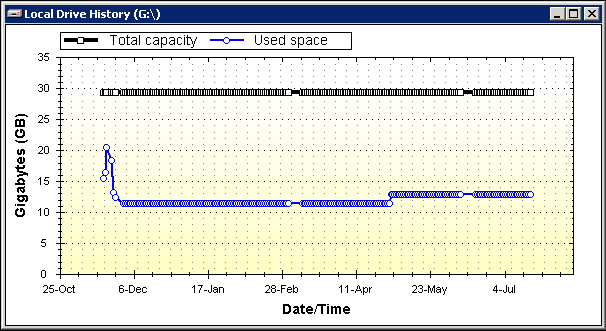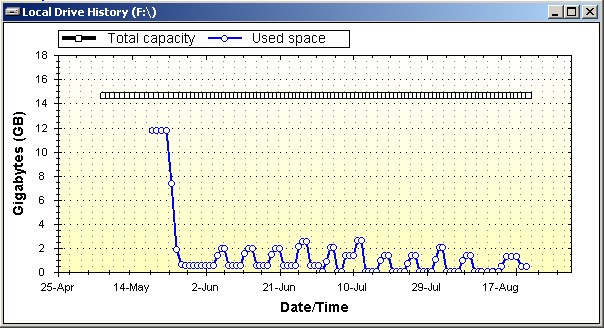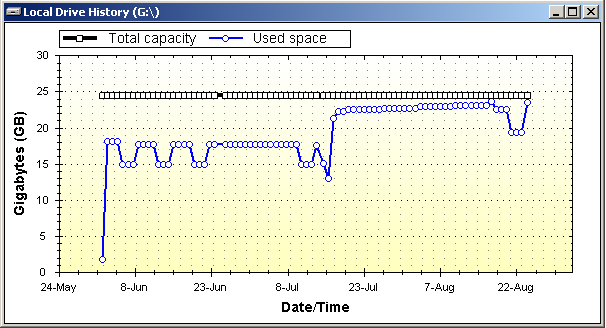13.6 Viewing the Server Disk Capacity and Used Space History
You can view the capacity and used space information about the disks on a Dynamic File Services server. Viewing the server’s disk history can help you understand space usage patterns for a disk for planning purposes. Sizes are reported in binary units (for example, 1 MB is 1024 bytes).
IMPORTANT:You can view the pair history (as described in Section 13.5, Viewing the Pair History) for each pair to determine how much space is being used by the primary path or secondary path on a disk.
You can also view the policy run history for a pair (as described in Section 13.2, Viewing the Policy Execution History for a Pair) to determine how much data is being moved by different policy runs on the pair.
13.6.1 Viewing Disk Details and History
-
In the Management Console, connect to the DynamicFS server you want to manage.
-
Right-click the server, then select .
-
Select the tab to view the following information for local disks on the target server:
Property
Description
Disks
List of the disks attached as local drives on the server. It shows their capacity, free space in gigabytes, and free space as a percentage.
File system
The file system type, such as NTFS.
Graphical display
A graph of the used space and free space on the selected disk.
Information is displayed by default about the C:\ drive.
-
Select a disk to view its file system, capacity, and used space information.

-
Select a disk and click to view information about how the used space has changed over time.

-
(Optional) Save the graphic display by right-clicking anywhere in a graphical area and selecting any of the following options:
-
Copy: Copies the selected graph as an image to the clipboard. Open a graphics editor, paste the image, and save the file.
-
Save Image As: Opens a Windows Save As dialog box where you can specify a location and file name for the image, select a file format, then save the file.
-
Page Setup: Set up the page orientation (portrait or landscape) and printer information for printing the graph.
-
Print: Print the selected graph.
-
13.6.2 Sample Disk History for a Primary Disk
The following sample Local Drive History graph displays the capacity history for a disk that is managed by Dynamic File Services, where the disk contains one or more primary paths of pairs. Policies were scheduled to run during non-peak hours so that the data could be moved over a period of days or weeks, depending on the amount of data to be moved, while allowing users to continue working with the data.

Initially, policies were run daily during non-peak traffic times on each pair to move files by type, size, or date last modified from the primary disk to a secondary disk (not pictured). Thereafter, the policy schedule was modified to run weekly during non-peak traffic times to move any new files that match the specified criteria from the primary disk to the secondary disk.
13.6.3 Sample Disk History for a Secondary Disk
The following sample Local Drive History graph shows a disk that contains one or more secondary paths of pairs. Initially, the disk contained little or no data. Over time, the disk capacity is being consumed by files that are moved by policies from primary paths on one or more other disks (not pictured) to their secondary paths on this disk.

Because the disk capacity is near its maximum, you might need to take one or more of the following actions:
-
Stop some policies from running by disabling their schedules, or by disassociating them from some pairs.
-
Create new policies to move some data back to the primary paths.
-
Stop using the disk as the secondary location for some pairs. This involves the following tasks:
-
Disassociate a pair from its current policies.
-
Create a new policy for the pair to move all of the files on the secondary path to the primary path. The policy can be scheduled to run in non-peak hours over several days or weeks, depending on how much data needs to be moved.
-
After all of the data has been returned to the primary location, unlink the primary path and the secondary path to remove the pair relationship between the two locations. This automatically disassociates the pair from any policies.
-
Create a new pair that links the primary path to a secondary path on a different disk.
-
Associate the pair with one or more policies to move specified file types to the new secondary location.
-
To help determine which pairs need to be modified, you can view the pair history (as described in Section 13.5, Viewing the Pair History) for each pair to determine how much space is being consumed by each pair’s secondary path. You can also view the policy run history for the pair (as described in Section 13.2, Viewing the Policy Execution History for a Pair) to determine if a policy is moving more data than you intended to be moved, and to understand how the policy might be modified to better meet your goals.